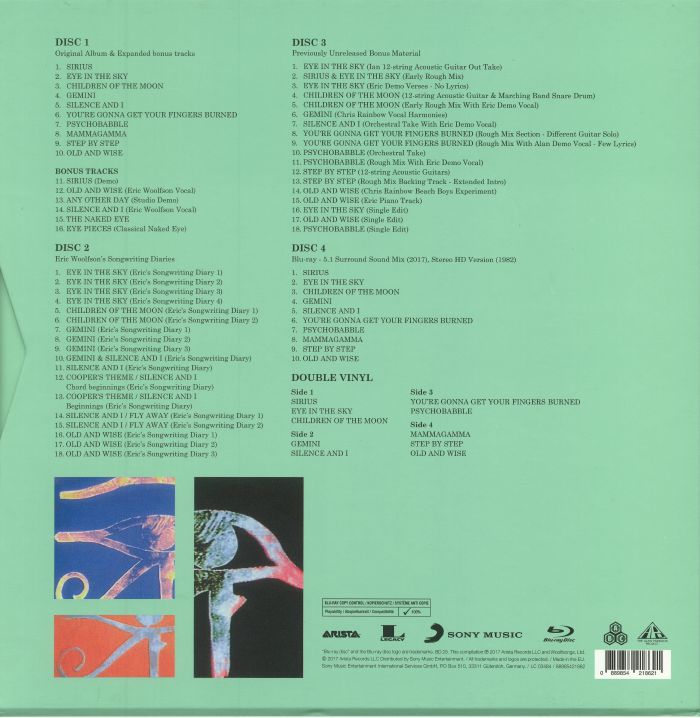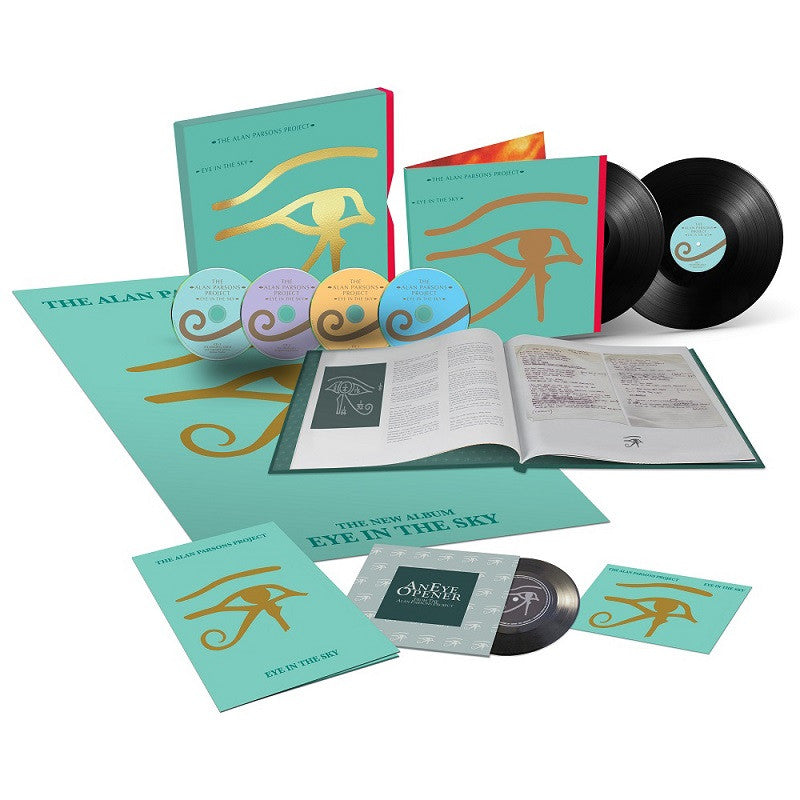Overall, this makes a nice addition to Mr. Parson's surround catalog.
I'd like to address several things.
The title track and its instrumental overture make for a great demo of the possibilities awaiting. If there's a singular feature of his work that is instantly recognizable it's his vocal sound. Breathy, choir-like harmonies adorn thick, breathy leads -- at least, when Mr. Woolfson is at the mic. The Alan Parsons sound was never more fully realized than when he sang lead. I nearly wish that Eric had helmed every track, though I am fully aware Mr. Parsons would not agree. There's a lot to making that sound. As it turns out, even more than I thought.
To explain, allow me a one-paragraph stopover with The Beach Boys. Wouldn't It be Nice, one of their most well-known hits, sounded nice on AM radio. On a fine system, the original mono never did much for me, nor did it inspire any particular appreciation for the group. But in 1997, before it burned a hole in my wool work pants, eighty dollars went for the new box set that contained the first stereo mix of the track. But what really fried my brain cells was the new stereo a capella mix -- just Brian Wilson and a couple others (not including Mike Love) putting in the master take. What a revelation! I'd simply had no idea, none at all, of the sheer beauty and nuance of what I'd been listening to all those years, buried under so many layers of mono. This unpleasant fact of multi-track recording -- the tendency to lose the stark deliciousness of basic tracks under further layers -- is well-known among engineers. Doug Sax put out a record years ago to demonstrate this -- The Sheffield Drum/Track Record. Today's a capella mixes provide a vocal companion to this phenomenon.
Can anything be done about this? Like the Beach Boys' track (although a far better recording), Eye in the Sky has a gorgeous vocal that is far less gorgeous the further down you go on the playback hierarchy (the one ending in a single 3" speaker). Here in multichannel, the vocal deconstructs in a way that is simply impossible in two channel. The chorus envelops you, and forces analysis: You've been here before -- yet you have not. Like a magic trick, you now wonder how it was done. There's a lot going on here, and as with The Beach Boys' track I found a new appreciation -- and wonder.
Then there are the drums. Confession: I've never really cared for his drum sound, at least on Pyramid through Ammonia Avenue. "Wimpy" is the word I'd use, with a wispy high end. It's not so much a case of passing years being unkind -- I thought likewise back in the day. With this release, Parsons has carried these same drum tracks into the 21st century. Still recognizable, yet much more contemporary. Tasty even. The high end is especially improved.
Other standout tracks: Silence and I -- a huge orchestral opus, and Psychobabble. This track left me cold in stereo, but now it really comes alive, sort of like a 5.1 mini-musical. It's choreographed, and you can't ignore it.
To discuss two tracks I had high hopes for but found disappointing, we have to discuss ... reverb. (REVERB reverb reverb). There has been a preference in this century to mix using much less reverb than in the "old days" (60's, 70's, and even 80's). In addition, the quality of reverb is a far cry. Gone are the physical chambers, springs, and metal plates of yesteryear with their too-noticeable character. All is now digital and true multichannel -- meaning any number of sources input can create a virtual soundfield. (This was not possible back in the quad era.) Tape-delayed "slap-back" reverb has been frowned on by some engineers since the early 80's (one in particular I knew bitched about Billy Joel's The Nylon Curtain for this trangression back in 1982). So today's reverb is cleaner, with less chararacter, and there's less of it.
Well I, for one, don't like things so dry. Although most of Goodbye Yellow Brick Road's surround remix featured near-perfect recreations of the original reverb, engineer Greg Penny apparently decided my favorite track Harmony simply went too far in this regard, and piled the track into the dryer on HIGH. This really wrecked it for me. Checkfield's Surrounded reaches the furthest extreme in this new desert culture. Some tracks -- e.g., Through the Lens -- are so bone dry they make listening uncomfortable. I once knew John, the band member who remixed them. If I ever see him again, I'll have that bone to pick. (He' lives in Costa Rica, so it's unlikely.)
So too Children of the Moon is, right from the intro, dried out. Parsons retains the deep reverb later on with the militant snares, but again is too shy with it on the chorale voces. We need reverb in this track to allow ourselves to slip away and fall under its spell but the lack of reverb takes me out of it. In addition, the fade-out is a little sloppy -- and Parsons' cross-fades were always so dramatic. Has the art of the smooth fade been lost to digital? It would seem so.
And to Gemini. A favorite track -- and "B" side to Eye -- turns out not as well as I'd hoped. Normally, I love discretely-separated vocals, but here -- there's something too obvious about the physical arrangement. In stereo, everything seemed organic -- new voices seemed to sprout like budding flowers on a single branch. But the real trouble is the ending, which builds up to ... nothing. In the stereo mix, the voices get noticeably louder in the climax, likely due to a manual pot-up by the engineer. Pot-ups (manual increases in track level during play) are also frowned upon as "unnatural" -- like cheating. Was Parsons averse to doing this now, though it was a crucial effect in the original version?
So there it is in one listen. I'm happy it exists, and happy to have it.
I don't know what number to give.
Maybe I'll give another listen first.
































